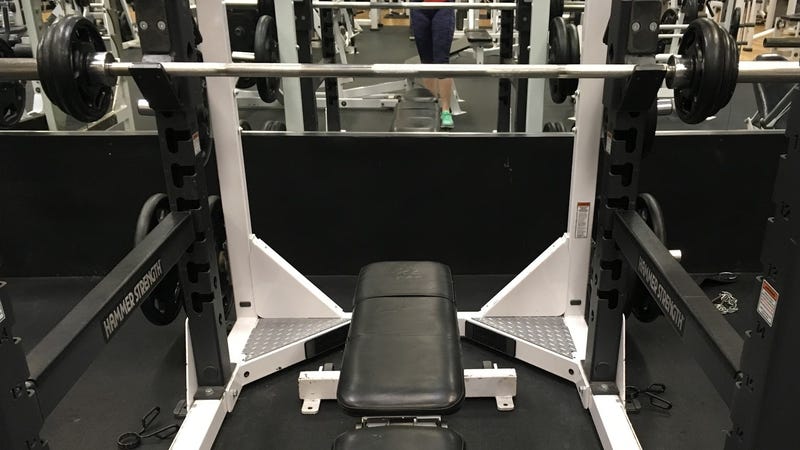
Lifting weights is often about the challenge: can I really lift this much? Or, I already lifted this for eight reps, but can I do a ninth? So you need to prepare for what happens if you fail.
If you’re following along with our bench press challenge, then you probably want to try to push your limits—but safely.
Advertisement
With barbell bench press, if you fail, the weight could crush your chest, neck, or face. That’s why people often do this exercise with a spotter, a friend who can help you get the weight back up if your arms start to buckle. But what if you’re friendless, or you’re just not sure if you trust anyone with this life-saving job?
You can avoid the situation entirely by pressing dumbbells instead, like we discussed last week, or by using a machine that mimics the bench press movement (like a Smith machine, or a chest press machine). But if you want to do a genuine barbell bench press without the help of a human being, all you need is a power cage with adjustable stops.
How to Set Up a Cage for Bench Press
The first time I tried this, it seemed impossible. You want to bring the bar down to touch your chest when you bench, but if you set up stops above your chest, how is that possible?
Advertisement
The trick is to bench with an arch in your back. Powerlifters can take this to an extreme, doing what looks like a yoga cobra pose turned 90 degrees. But to bench safely in a rack, you just need a few inches of arch.
Don’t forget that the bar should touch your sternum (right under your boobs, if you have boobs) on each rep—not your upper chest or your shoulders.
So you set the stops where they are even with the surface of your chest when your back is flat, and then you arch your back so your chest is just slightly above the stops.
- First, drag a bench into the rack. (This isn’t always easy, but look for a rack with wheels on one end. Pick up the other end and it will pivot and steer nicely when you hold it almost-vertical.)
- Then, set the stops a chest-width above the bench, and the rack to hold the bar a few notches above that.
- Lie down on the bench to check positioning with the empty bar. You should be able to easily grab the bar with bent elbows, press it up so your arms are straight, and lower it down to touch your puffed-out chest.
- Try escaping from under the bar: let it rest on the stops, and flatten your back and try to slide out from under it. It’s fine to slide or roll the bar toward your hips so you can comfortably sit up.
Once you have everything adjusted properly, jot down which notches you used so you can set up quickly next time. Some racks have numbered settings, but with others you’ll have to write, say, “fourth one from the bottom and then six notches above that.” Do what works.
Advertisement
If you need a visual, this video breaks it down nicely. (Fair warning: the beginning of the video shows the narrator dropping 315 pounds on his chest without a rack, but he doesn’t die. Skip to 0:42 if you don’t want to see that.)
So, how are you feeling about your bench press? Ready to try it with a barbell, or ready to ditch your spotter for some metal bars that will be less likely to get distracted when you’re in your moment of need?
from Lifehacker https://lifehacker.com
via IFTTT